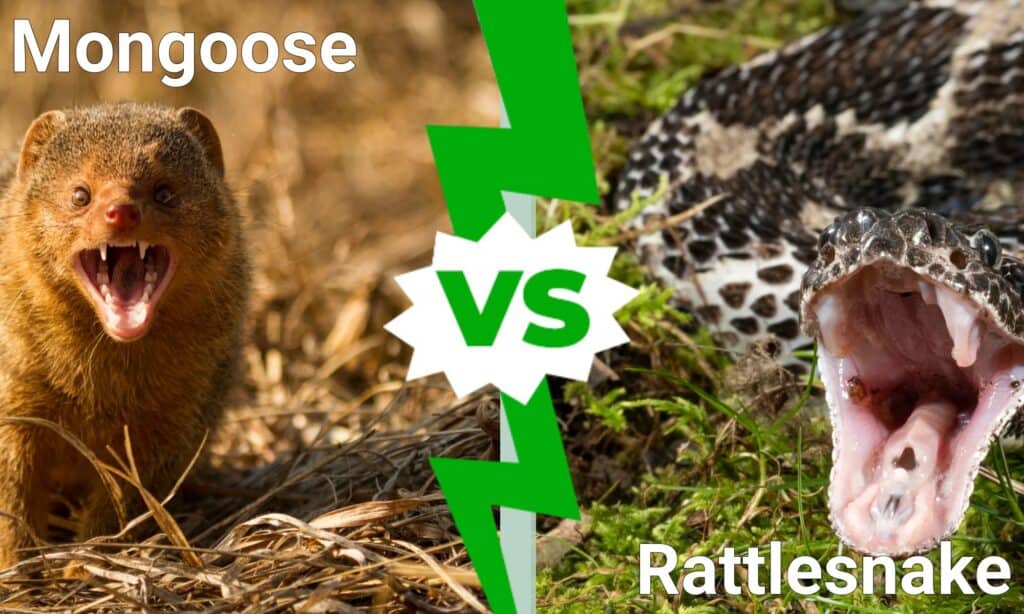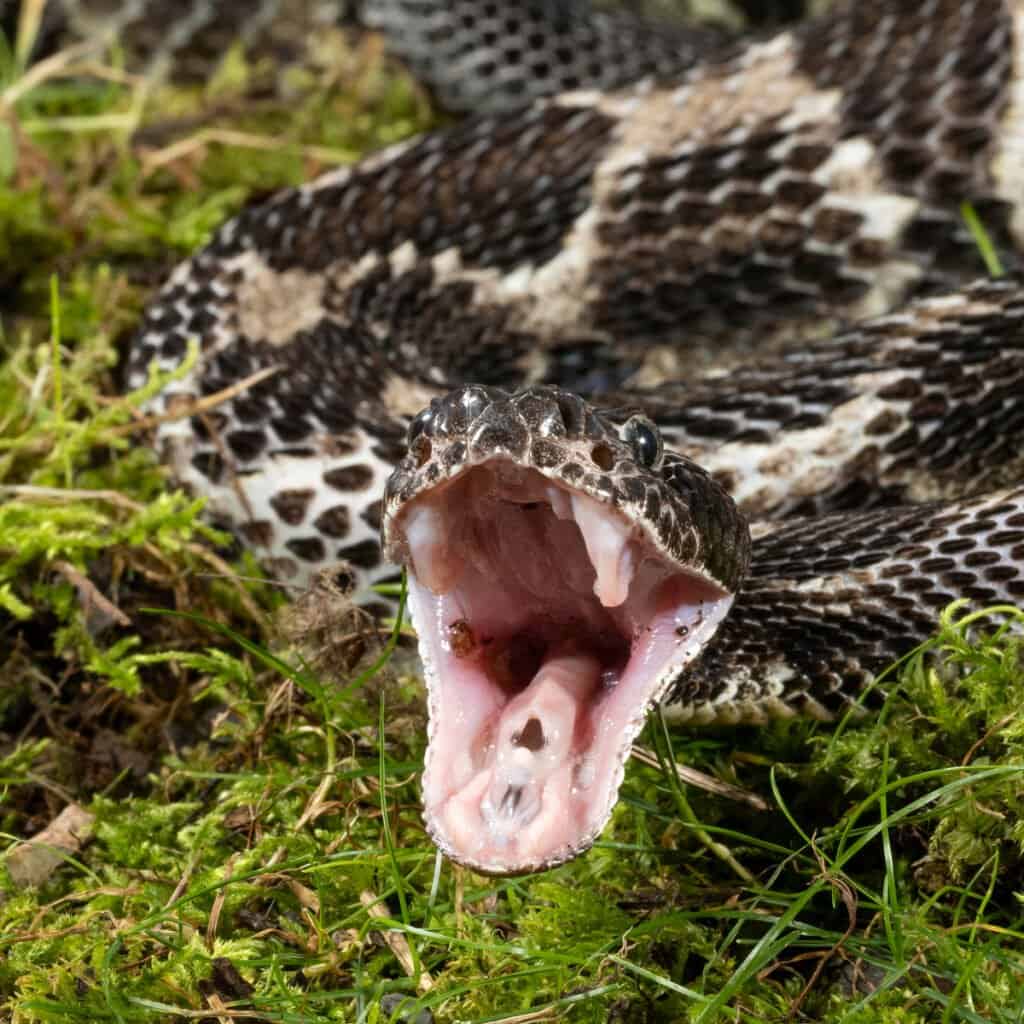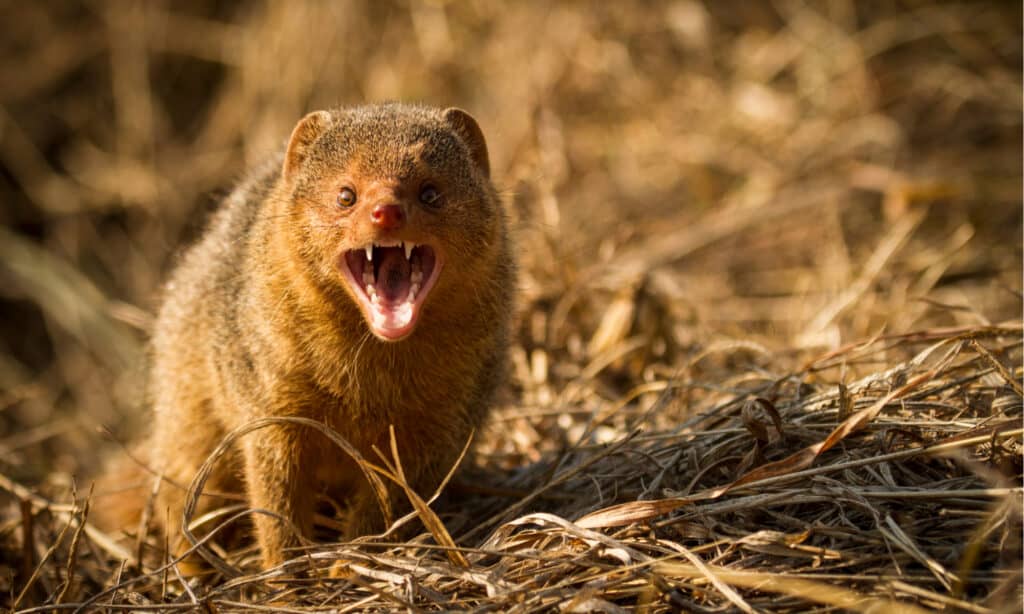The mongoose is a small and sleek mammal with a reputation for bold behavior. Although adept hunters, they have horizontal pupils, similar to animals like sheep and horses, to help avoid predators. This is in contrast to the elliptical, slit-like pupils of the venomous predatory viper, the rattlesnake. We’ve already covered the battle between a king cobra and a mongoose. The rattlesnake is a fanged serpent with incredible striking power, but the mongoose may have evolved some resistance to snake venom. Let’s look at mongoose vs rattlesnake, who would win the fight?
Comparing a Mongoose and a Rattlesnake

| Mongoose | Rattlesnake | |
| Size | Up to 50 in long, 11 lbs | Up to 96 in long, 10 lbs |
| Speed & Movement | 20 mph, agile movement | 2-3 mph, quick strikes |
| Attack Method | Claw & bite | Strike with venomous fangs |
| Physical Defenses | Venom resistance, thick fur, claws | Rattle & hiss warning, camouflage |
| Predatory Behavior | Pursuit predator | Ambush predator |
Key Differences Between a Mongoose and a Rattlesnake
The main differences between a mongoose and a rattlesnake are their speed, morphology, defensive methods, and attack methods. Mongooses have the ability to evade predators at speeds up to 20 miles per hour. Rattlesnakes travel at slower speeds of 2 to 3 miles per hour, but they can strike out in the blink of an eye to inject their powerful venom. The speed and agility of the mongoose may help them evade the skilled strike of a determined rattlesnake. We can only guess how this match would end until we’ve looked at all the factors specific to the outcome of the fight.
What are the Key Factors in a Mongoose and a Rattlesnake Fight?

Rattlesnakes have the cat-like pupils common in predators, while the mongoose has horizontal ones like those of a sheep
©DMartin09/Shutterstock.com
Some key factors in a mongoose vs rattlesnake fight would be their size, speed and attacking methods. We also need to consider their physical defenses and predatory behavior to determine who would be victorious in this match.
Mongoose Vs Rattlesnake: Size
The mongoose varies in size depending on the specific species. The dwarf mongoose has an average body length of 7 inches. The massive Egyptian mongoose is around 25 inches long with an additional 25-inch tail, for a total of 50 inches head to tail. The largest species of mongoose can weigh up to 11 pounds as an adult. So how does this house cat-sized mammal compare to the reptilian rattlesnake? Rattlesnakes also grow to a range of sizes, depending on the species. The pygmy rattlesnake is the smallest species and grows to an average length of 20 inches. The eastern diamondback is the largest rattlesnake species, growing up to 96 inches in length and weighing up to 10 pounds (and even more in extreme cases). Depending on the specific individuals involved in the match, the mongoose and rattlesnake could be similarly sized opponents.
In terms of size, neither the mongoose nor the rattlesnake necessarily has the size advantage.
Mongoose Vs Rattlesnake: Speed & Movement

Mongoose can reach speeds of 20 miles per hour while the slower rattlesnake can strike in the blink of an eye
©Oscar David Toledo Marin/Shutterstock.com
The mongoose is an agile creature capable of quick and cunning movements to capture their prey and avoid predation. As mentioned, they can reach speeds of up to 20 miles per hour. The rattlesnake is slower at 2 to 3 miles per hour. However, they’re able to complete an accurate strike of up to half their body length in just the blink of an eye. This strike is only accomplished when the snake is able to prepare from it from a coiled position. Overall, the mongoose is likely to have the moves to avoid a strike and could certainly outrun the rattlesnake if need be.
The mongoose has the advantage over the rattlesnake in speed and movement.
Mongoose Vs Rattlesnake: Attack Method

It takes rattlesnakes have a second to strike but mongooses have resistance to their venom
©Joe McDonald/Shutterstock.com
Mongooses are skilled hunters with remarkable reflexes. They have keen senses of sight, smell and hearing and use their powerful bite to kill their prey. They have 28 teeth, including 4 long incisors capable of cracking bones. Their strong claws are helpful for digging as well as providing protection from predators. Rattlesnakes attack by striking their prey and sinking their powerful fangs into their victim. Their fangs deliver venom immediately, it takes half a second for the snake to strike and paralyze prey. Their hemotoxic venom works by destroying red blood cells, leading to organ degeneration and tissue damage. Some species, like the Mojave, speckled, and tiger rattlesnakes have neurotoxic venom, which acts faster than hemotoxins and attacks the nervous system. Since mongooses may have resistance to their venom in addition to bite power and skin-shredding claws they seem to have the upper hand in the attack.
The mongoose has the advantage over the rattlesnake in the attack method.
Mongoose Vs Rattlesnake: Physical Defenses

Timber Rattlesnakes strike quickly
©Mark Sheridan-Johnson/Shutterstock.com
The mongoose has thick, protective fur, strong skin, and sharp claws that would all be helpful against a rattlesnake strike. Research has shown that as an ophiophagus, or snake-eating mammal, the mongoose has developed some venom resistance. However, repeated strikes would have a high potential of injuring or even killing them. Rattlesnakes know how to blend into their environments and stay still in order to keep out of sight before surprising their victims. In addition to shaking the rattles at the ends of their tails to warn of a strike, rattlesnakes will often hiss like a cat. Their body will swell and deflate as they take air in and out to produce the sound. When threatened, they make a move to coil in a tight circle and raise their heads in preparation for the strike. Even if the rattlesnake did land the first strike, the mongoose would likely be in the position to continue in battle.
The mongoose has the defensive advantage.
Mongoose Vs Rattlesnake: Predatory Behavior

Mongoose like to chase their prey in hot pursuit unlike the rattlesnakes who prefer to sit and wait for a strike
Mongooses engage in pursuit predation, actively chasing their prey to capture them with their sharp claws and powerful bite. They often hunt alone but may also pursue in groups. Some species live in cooperation with a pack with individuals responsible for specific duties. This means that the most skilled hunters would be sent out to catch and kill prey to bring back and share with the members of their group that have stayed behind. The Gambian mongoose is particularly social, living in packs of 50 members or more.
As solitary ambush predators, rattlesnakes use the method of sitting still and waiting for unsuspecting prey to pass by. These pit vipers have heat-sensing organs located near their eyes. These allow them to sense the heat signatures of animals around them. So even in the dark, they’d be able to strike accurately. They have a highly-developed organ or chemoreception called Jacobson’s organ that allows them to detect and hunt their prey. The rattlesnake could certainly take the mongoose by surprise, but a skilled mongoose hunter may easily pursue a rattlesnake.
Neither the mongoose nor the rattlesnake has the predatory advantage.
Who Would Win in a Fight Between a Mongoose and a Rattlesnake?
The mongoose and rattlesnake are sizable opponents well-matched in terms of predatory behavior. However, the mongoose is a quick and clever mammal with many means of effective pursuit and defense. Thick fur and physiological resistance to rattlesnake venom definitely gives them the upper hand in this battle. Mongooses are known to consume venomous snakes and it seems likely that this would be the outcome of this match. Although the rattlesnake could get lucky in the match, we’ve determined that the mongoose would win in the mongoose vs rattlesnake fight.
The photo featured at the top of this post is © Joe McDonald/Shutterstock.com
Thank you for reading! Have some feedback for us? Contact the AZ Animals editorial team.






